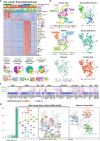Comprehensive characterization of 536 patient-derived xenograft models prioritizes candidatesfor targeted treatment
- PMID: 34429404
- PMCID: PMC8384880
- DOI: 10.1038/s41467-021-25177-3
Comprehensive characterization of 536 patient-derived xenograft models prioritizes candidatesfor targeted treatment
Erratum in
-
Author Correction: Comprehensive characterization of 536 patient-derived xenograft models prioritizes candidates for targeted treatment.Nat Commun. 2022 Jan 7;13(1):294. doi: 10.1038/s41467-021-27678-7. Nat Commun. 2022. PMID: 34996889 Free PMC article. No abstract available.
Abstract
Development of candidate cancer treatments is a resource-intensive process, with the research community continuing to investigate options beyond static genomic characterization. Toward this goal, we have established the genomic landscapes of 536 patient-derived xenograft (PDX) models across 25 cancer types, together with mutation, copy number, fusion, transcriptomic profiles, and NCI-MATCH arms. Compared with human tumors, PDXs typically have higher purity and fit to investigate dynamic driver events and molecular properties via multiple time points from same case PDXs. Here, we report on dynamic genomic landscapes and pharmacogenomic associations, including associations between activating oncogenic events and drugs, correlations between whole-genome duplications and subclone events, and the potential PDX models for NCI-MATCH trials. Lastly, we provide a web portal having comprehensive pan-cancer PDX genomic profiles and source code to facilitate identification of more druggable events and further insights into PDXs' recapitulation of human tumors.
© 2021. The Author(s).
Conflict of interest statement
The University of Utah may choose to license PDX models developed in the Welm labs, which may result in tangible property royalties to Drs. Welm and members of their labs who developed the models. M.T.L. is a founder and limited partner in StemMed Ltd. and a manager in StemMed Holdings, its general partner. He is a founder and equity stakeholder in Tvardi Theraeutics Inc. Some PDXs are exclusively licensed to StemMed Ltd. resulting in royalty income to M.T.L. L.E.D. is a compensated employee of StemMed Ltd. The other authors declare no competing interests.
Figures







References
-
- Tuveson D, Clevers H. Cancer modeling meets human organoid technology. Science. 2019;364:952–955. - PubMed
Publication types
MeSH terms
Associated data
Grants and funding
- 75N91019D00024/CA/NCI NIH HHS/United States
- U54 CA233223/CA/NCI NIH HHS/United States
- P30 CA034196/CA/NCI NIH HHS/United States
- UL1 TR003167/TR/NCATS NIH HHS/United States
- HHSN261201400008C/CA/NCI NIH HHS/United States
- K08 CA237732/CA/NCI NIH HHS/United States
- U24 CA224067/CA/NCI NIH HHS/United States
- U54 CA224070/CA/NCI NIH HHS/United States
- HHSN261200800001C/RC/CCR NIH HHS/United States
- U54 CA224076/CA/NCI NIH HHS/United States
- U54 CA224065/CA/NCI NIH HHS/United States
- U54 CA233306/CA/NCI NIH HHS/United States
- P30 CA010815/CA/NCI NIH HHS/United States
- U54 CA224083/CA/NCI NIH HHS/United States
- HHSN261201500003C/CA/NCI NIH HHS/United States
- R50 CA211199/CA/NCI NIH HHS/United States
- P30 CA125123/CA/NCI NIH HHS/United States
- P50 CA070907/CA/NCI NIH HHS/United States
- HHSN261201500003I/CA/NCI NIH HHS/United States
- HHSN261200800001E/CA/NCI NIH HHS/United States
- P30 CA042014/CA/NCI NIH HHS/United States

